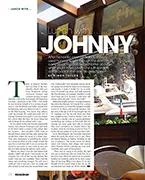Anderson says that in such situations, storms (metaphorical and literal) have to be weathered. “You have to survive that sort of thing. If you give it all up, then everything you’ve done for the weekend goes down the pan.”
In coming through the adverse conditions, Herbert utilised not only his experience of driving F1 cars but also his crucial knowledge of the circuit’s idiosyncratic weather patterns.
“At the Nürburgring, it rains generally at one end or the other,” Herbert said in a recent Sky feature, “There was a massive, strong wind coming up the straight. We always know the weather will come in that direction. That was something I was able to use to my advantage later on.”
As the track dried, drivers on wets were forced to make another stop to swap back to slicks. The Stewart driver continued his progress to move up into sixth when Prost’s Jarno Trulli pitted on lap 29 – Herbert was now in the points.
As if the race hadn’t been chaotic enough up to this point, all hell was soon to break loose – again.
On lap 31, Frentzen pitted from the race lead. As he exited the pitlane, he forgot to disengage a secret anti-stall system the Jordan team had on their car. It was the same problem suffered by Hill, and the second stricken Jordan came to a juddering halt in almost exactly the same spot.
“I went ‘that cloud there, she’s gonna come over the whole circuit. It’s worth a gamble – Wets, Wets, Wets!’”
Herbert had now risen to fifth and team-mate Barrichello was third. On lap 34, the rain came back with a renewed vengeance.
It was the Brit’s second big tyre choice to make. Ride it out on drys again or fit the right tyres for the job? Herbert again used his knowledge of the circuit’s geography and weather patterns to make the call.
“By the time I got to the far end of the circuit, it was bucketing down,” said Herbert, “I went ‘that cloud there, she’s gonna come over the whole circuit. It’s worth a gamble – Wets, Wets, Wets!’”
Anderson had his own failsafe method of tracking the weather. “I have a piece of blue paper roll on the back of my clipboard. Based on that, I made some decisions. I used that for many years: stick it out in the rain, see how quickly it gets wet. It gives you a good indication as to how big the drops are and gives a good indication to where you really are.”
It just so happened that the deluge coincided with Herbert’s scheduled stop – and blue roll would combine with driver judgement to make the call for wet tyres.
“Every race is just a reaction to the situation,” says Anderson And that was a reaction to a situation, opening an opportunity and because of others not getting it, not being able to survive, we ended up being able to benefit from that. Johnny had to pit then, it wasn’t a case of doing another five laps and then ‘we’ll wait and see.’”
As others dived into the pits too, Herbert maintained track position and remained in fifth.
Here Barrichello made a fatal error, one which would massively benefit Herbert. The Brazilian had prayed for rain prior to the race, thinking that that would be his big chance to take his debut win.
When the heavy downpour arrived though, Barrichello went against his original instinct. Convincing himself it was just another passing shower, he took on slicks again.
Anderson says the team offered their Brazilian charge the chance to move onto wets: “There’s a little bit of controversy about that because Rubens was offered the same opportunity to come in by myself. I said to him ‘I’m pretty sure it’s gonna piss down.’ And the answer was ‘No, no. We’ll be okay on slicks.’”
In a recent F1 interview, Barrichello said: “I had been wishing for more rain and more rain and I was asking for something that came my way – but I kept the slicks. For two laps, I was so slow on the slicks, I lost the race because of that. It’s fundamental that whenever you ask for something, you are ready to grab it and I wasn’t.”











